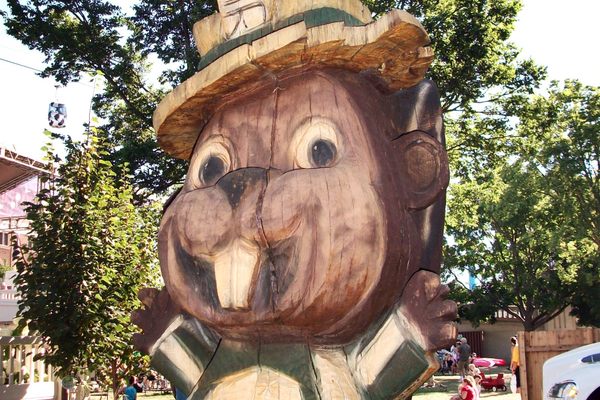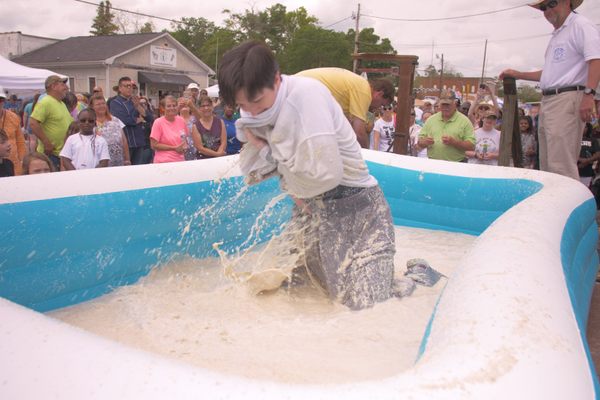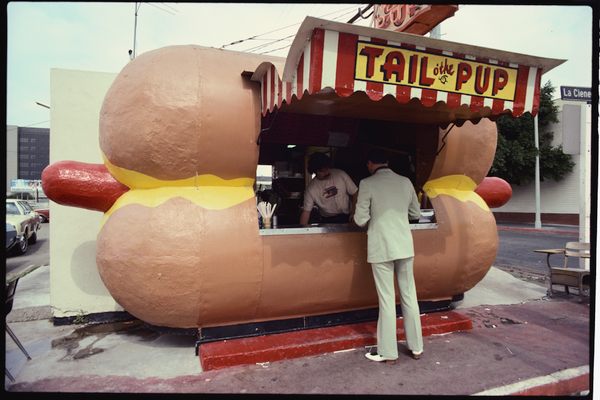Before the Music Festival, Coachella Valley Promoted Itself With an Arabian Fantasy
Celebrating the local date industry involved a Queen Scheherazade beauty pageant, vendors in veils, and a Taj Mahal.

At first glance, the Riverside County Fair and National Date Festival in the Coachella Valley town of Indio, California, looks like any local fair. The monster trucks are lined up, the Twinkies are frying, and ferris wheels gleam in the desert sun. But other details are out of the ordinary: The fair poster faintly resembles the sweeps and curves of Arabic calligraphy. Domes and minarets appear on the horizon. The official Fair ambassadors—elegant young ladies, becrowned and wearing sequined, midriff-baring skirts or harem pants—wave regally. Say hello to Queen Scheherazade and her court.
Held between February 15 and 24, this was the festival’s 73rd year. Although dates are no longer the highlight, and the fair positions itself like any other county fair with carnival rides, livestock exhibits, and musical entertainment, the festival still incorporates curiously “Arabic” elements, which feel out of place in a region that is 71 percent Hispanic and 25 percent white, with a Muslim population in the mere hundreds.
It all began, as most stories of fruit in America do, with the USDA. At the turn of the 20th century, the United States Department of Agriculture’s mission to improve the nation’s agricultural diversity led to the import of date varieties from the Middle East and Algeria to the Coachella Valley. By the early 1900s, promoters launched ambitious marketing campaigns to boost the industry. Taking advantage of the desert landscape, Coachella Valley towns refashioned themselves as American counterparts of the Middle East. The town of Walters became Mecca in 1904, and several streets in the Valley got names like Cairo Avenue and Medina Street, which still exist today. The Coachella Valley High School mascot became the image of an Arab in a keffiyeh. Date shops were designed as replicas of pyramids and Bedouin tents. A festival celebrating the fruit was the natural next step.
In 1921, the town of Indio, located 130 miles from Los Angeles, launched the “International Festival of Dates.” Local press reported that “seven society ladies” had donned Arabian costumes at the opening ceremony, creating a sensation. The promotional pamphlet included an illustration with bedouin tents, camels, and the legend: All “The Wise Men” are going.
After that first date festival, though, interest dwindled until 1938, when the Riverside County Fair merged with the Indio Civic Club (organizers of the date festival) to form the Riverside County Fair and National Date Festival. With a brief pause during the Second World War, the festival has run continuously since, held in mid-February every year. The county fair added traditional American events such as rodeos, carnival rides, and funnel cakes, but the love of faux-Arabia remained.

“In the early half of the 20th century, the Middle East is romanticized and thought of as the place of One Thousand and One Arabian Nights,” says Sarah Seekatz, an associate professor at San Joaquin Delta College, who wrote her doctoral dissertation on the creation of “America’s Arabia” to promote the Coachella Valley’s date industry. “It’s seen as glamorous and luxurious and sex-crazed, but also dangerous.” The enthused adoption of a mythic Arabia as the cultural identity of this date-producing town was a convenient way to market the community and the festival for tourism. The motive was “you should visit us, and you should be a tourist because we are this place where you can travel the world without leaving the state,” explains Seekatz, who also chronicled the date festival as part of her dissertation.
The Arabian Nights theme took off after World War II. A local artist, Louise Dardenelle, conceived the Arabian Nights pageant, which became an annual tradition of plays adapted from One Thousand and One Nights (more commonly called Arabian Nights). The production needed a stage, and retired Hollywood art director Harry Oliver, known for his immoderate replicas of bygone eras, built the faux-Middle Eastern Baghdad Stage, replete with minarets, Moorish arches, and latticed windows. The Islamic style was not rooted to any actual place of Islamic heritage. On either side of one facade, signs written in Arabic respectively read “Pastry Shop” and “Dates Shop—The Only One in America.” On the middle wall, a sign written in Farsi said, “Arabian Foods & Sweet Meats.”
The Arab fantasia in the fairgrounds architecture was pan-Islamic, stretching beyond the Middle East for inspiration. Besides the Baghdad stage, there is the Taj Mahal building, which has a mural of the actual Taj Mahal on one exterior wall. Other areas have names such as Shalimar Lawn and Magic Carpet Stage.
Like the annual play, the Queen Scheherazade beauty pageant has been held since 1948. Contestants, most of them accomplished local students, dress in bejewelled, gossamer-thin harem pants, and compete for scholarship money. The Queen and her court, comprising a Princess Dunyazade and Princess Jasmine (the first and second runners-up), greet fairgoers and make promotional appearances.

Both the Arabian Nights pageant and the Queen Scheherazade contest have become enduring traditions. At first the pageant was a community affair, showcasing local talent, but its popularity has led to professionals doing costume and theatrical design. It is now California’s second-oldest outdoor play, outrun only by the Ramona pageant, in neighboring Hemet, writes Seekatz, in her 2016 book, Images of America: Indio’s Date Festival.
Seekatz has been tracking how the festival has changed over the years. In the beginning, local businesses and vendors participated in the Orientalist depictions, dressing up in Arab garments—headdresses, veils, and all. But by the 1970s and ‘80s, the depiction of the greater Middle East was beginning to change in the United States, spurred by geopolitical turmoil such as the Iran hostage crisis, oil embargoes, and the Gulf War. The days of a blue-eyed Peter O’Toole in Lawrence of Arabia or an electric Elizabeth Taylor in Cleopatra—portrayals that glorified the mythic Orient—were over. After 9/11, American popular culture overwhelmingly depicted Muslims as terrorists and threats.
The fair followed suit. In 2003, the fair’s shooting gallery used a sketch of an Arab as targets. The camel races were run by men in U.S. military garb, not Arab headdresses, as in the past. An American flag was raised on the Baghdad stage, in an event called “Salute to America,” which preceded the Arabian Nights musical pageant, and has become a continuing tradition. “Let’s face it, it’s kinda weird now, this Arab thing,” a fairgoer told Lorraine Ali, a journalist who wrote about visiting the fair as a child in the 1970s and then returning after 9/11.

There are hardly any Middle Eastern voices in coverage of the festival, so it’s hard to tell what actual Muslims thought of the cultural appropriation. Seekatz directed me to Ali’s 2003 article in Newsweek. She writes about her bewilderment at the sight of blue-eyed men in fez caps at the 1973 festival, which she attended with her father, an immigrant from Baghdad. But the initial confusion gave way to joy. “[We’d] whoop and holler at the camel races and marveled at the pyramid of dates in the Taj Mahal building—India? Arabia? Who cared?—and ate corn dogs next to freckled kids at the ‘Arabian Nights’ pageant.”
In many ways the framework of the date festival mirrored that of its primary source of inspiration. The tales of One Thousand and One Nights draw from Arab and Indian folklore, from Ottoman literature and Egyptian mythology. Its status as global folklore has given it a universalism that has led to widespread adaptations. The tales, and particularly the character of Scheherazade, have inspired writers as diverse as Jorge Luis Borges, Neil Gaiman, Haruki Murakami, and Salman Rushdie. That a small community in Southern California might also like to use it to celebrate (and sell) their date industry is perhaps not the point of contention. Ali’s dad deemed the genies and flying carpets too innocent to cause offense.
Perhaps what irked Ali is how the date festival used the fantasy of Arabia like its own genie in a bottle: a powerful, wish-granting force that could be subdued and called to action at will. The organizers used grand domes and beautiful harem women as a marketing trope when it was convenient. But when this notional Muslim world became threatening in the national consciousness, the turbaned Arab face became a target at the gun range, the costumes were (mostly) retired under the guise of heightened political awareness, and the remaining vestiges of mythical Arabia were preceded by reassuring renditions of patriotism, such as the American flag flying on the Baghdad stage (which appears on this year’s Fair calendar simply as “Pageant stage”). “I couldn’t help feeling that the fair was apologizing for once having promoted a place and people whose very existence is now viewed as anti-American,” rued Ali.

The Fair might have taken a cue from Coachella Valley High School, which responded positively in 2014 to a complaint from the American-Arab Anti-Discrimination Committee about its snarling Arab mascot. The school designed a new mascot, featuring the image of a “Mighty Arab,” which honored the school’s heritage without propagating Islamophobic stereotypes (and was approved by the Committee).
As the Coachella Valley grew more diverse, populated with newer arrivals who had no connection to the date industry, and the industry itself found other ways to sell its fruit, the allegiance to the Valley’s Arabian mythmaking waned. The fair’s date vendors have found other avenues of promotion, current Fair manager, Veronica Casper, writes in an email. Today, visitors might amble amongst date groves and enjoy a date shake or ice cream. There are still date-focused cook-offs at the fair, and some vendors sell date shakes and other treats, including date beer, but the offerings are meagre compared to the festival’s early days.
This was the first year without the fair’s camel and ostrich races, although camels were there for rides and an educational exhibit, according to Casper. Today, a Disneyfied Aladdin, stripped of any significant allusions to an Islamic world, is one of the last vestiges of a long affair with a mythic Middle East. The Oriental sheen remains, but only as the feeble afterglow of a remarkable cultural and agricultural heritage.
Gastro Obscura covers the world’s most wondrous food and drink.
Sign up for our email, delivered twice a week.
































Follow us on Twitter to get the latest on the world's hidden wonders.
Like us on Facebook to get the latest on the world's hidden wonders.
Follow us on Twitter Like us on Facebook